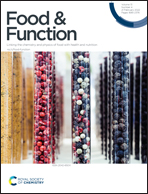Transcriptome analysis provides insight into the anti-diabetic mechanism of theaflavins in high-fat diet and streptozotocin-induced mice†
Abstract
Black tea exhibits potential to improve hyperglycemia and insulin resistance, where theaflavins (TFs) are its characteristic components. The aim of this study was to explore the anti-diabetic mechanism of TFs. High-fat diet and streptozotocin-induced type 2 diabetes (T2D) mice were administered with TFs by gavage daily for 5 weeks. The biochemical analysis suggested that TFs possess potential anti-diabetic activity, which is comparable to that of metformin. RNA-sequencing analysis showed that TFs had a significant influence on the hepatic transcriptional profile of the T2D mice. The nine significantly enriched KEGG pathways were mainly associated with pancreatic secretion, digestion and metabolism of fat, protein and glycerolipid, and tight junctions. Quantitative real-time PCR and immunohistochemistry analysis verified that TFs improved pancreas function and intestine tight junction, with an increase in the expression of carboxyl ester lipase (Cel), chymotrypsinogen B (Ctrb1), pancreatic triglyceride lipase (Pnlip) and chymotrypsin-like elastase 3B (Cela3b) in the pancreas and cingulin and claudin-1 in the intestine. TFs improved mitochondrial biogenesis with the downregulation of peroxisome proliferator-activated receptor coactivator (PGC) 1α and 1β in the liver, but had less effect on the muscle. This work revealed the comprehensive mechanism of TFs against T2D, suggesting that TFs are a potential natural agent for improving type 2 diabetes.



 Please wait while we load your content...
Please wait while we load your content...